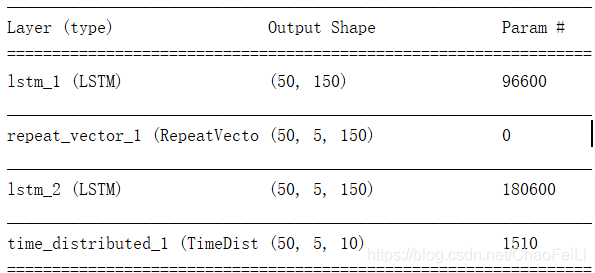-
一、前言
1、TimeDistributed和Dense的使用
下面代码是keras里面给出的解释:
# as the first layer in a model
model = Sequential()
model.add(TimeDistributed(Dense(8), input_shape=(10, 16)))
# now model.output_shape == (None, 10, 8)从上述代码中可以发现,TimeDistributed和Dense一起配合使用,主要应用于一对多,多对多的情况。
input_shape = (10,16),表示步长是10,每一步的维度为16,(即:每一个数据的属性长度为16))
首先使用TimeDistributed(Dense(8),input_shape = (10,16))把每一步的维度为16变成8,不改变步长的大小
若该层的批输入形状然后(50, 10, 16),则这一层之后的输出为(50, 10, 8)
2、RepeatVector的使用
这个是keras官网给出的解释
```python
model = Sequential()
model.add(Dense(32, input_dim=32))
# now: model.output_shape == (None, 32)
# note: `None` is the batch dimension
model.add(RepeatVector(3))
# now: model.output_shape == (None, 3, 32)
```解释:如果输入的形状为(None,32),经过添加RepeatVector(3)层之后,输出变为(None,3,32),RepeatVector不改变我们的步长,改变我们的每一步的维数(即:属性长度)
-
二、一对多
from keras.models import Sequential
from keras.layers import LSTM,Dense,TimeDistributed,RepeatVector
batch_size = 50
n_in = 1
vector = 10
n_out = 5
model = Sequential()
model.add(LSTM(150, batch_input_shape=(batch_size, n_in, vector), stateful=True))
model.add(RepeatVector(n_out))
model.add(LSTM(150, return_sequences=True, stateful=True))
model.add(TimeDistributed(Dense(vector, activation='softmax')))
print(model.summary())
解释:输入的数据结构为(50,1,10),输出的数据结构为(50,5,10),实现了一对多
-
三、多对多
3.1、多对多之输入与输出的序列长度相同
from keras.models import Sequential
from keras.layers import LSTM, Dense, TimeDistributed, RepeatVector
batch_size = 50
in_steps = 10
in_vector = 10
out_vector = 100
model = Sequential()
model.add(LSTM(150, batch_input_shape=(batch_size, in_steps, in_vector), stateful=True, return_sequences=True))
model.add(TimeDistributed(Dense(out_vector, activation='softmax')))
print(model.summary())

解释:输入的数据结构为(50,10,10),输出的数据结构为(50,10,100),实现了多对多中的输入与输入序列长度相同
3.2、多对多之输入与输出的序列长度不同
from keras.models import Sequential
from keras.layers import LSTM, Dense, TimeDistributed, RepeatVector
batch_size = 50
in_steps = 10
in_vector = 10
out_vector = 100
model = Sequential()
model.add(LSTM(150, batch_input_shape=(batch_size, in_steps, in_vector), stateful=True))
model.add(RepeatVector(20))
model.add(TimeDistributed(Dense(out_vector, activation='softmax')))
print(model.summary())

解释:输入的数据结构为(50,10,10),输出的数据结构为(50,20,100),实现了多对多中的输入与输入序列长度不同
部分代码解释:
model.add(LSTM(150, batch_input_shape=(batch_size, in_steps, in_vector), stateful=True))
model.add(RepeatVector(20))在LSTM后面添加RepeatVector层的时候,必须保障没有在LSTM中没有return_sequences=True,因为RepeatVector需要的是二维输入,而不是三维
model.add(LSTM(150, batch_input_shape=(batch_size, in_steps, in_vector), stateful=True,return_sequences=True))
model.add(TimeDistributed(Dense(out_vector, activation='softmax')))在LSTM后面添加TimeDistributed层的时候,必须保障在LSTM中有return_sequences=True,因为TimeDistributed需要的是三维输入。
小贴士:
RepeatVector主要作用于步长
TimeDistributed主要作用于每一步向量长度(即:属性大小)